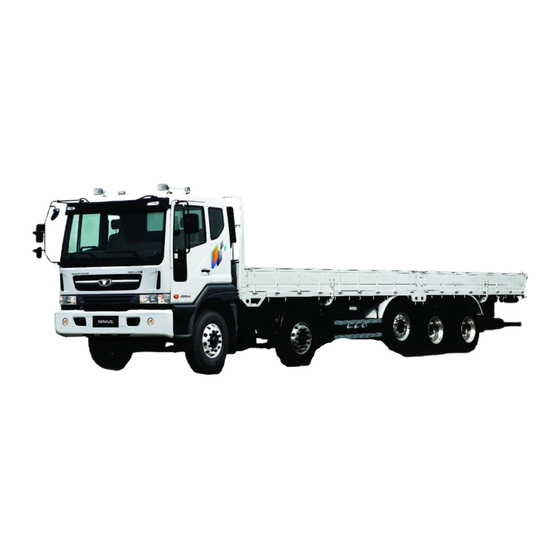
Table of Contents
Advertisement
Quick Links
We would like to take this opportunity to thank you for choosing a TATA
DAEWOO product and assure you for our continuing interest in your
motoring pleasure and satisfaction.
This manual has been prepared to acquaint you with the operation and
maintenance of your new TATA DAEWOO TRUCK and to provide
important safety information. We urge you to read it carefully and follow
the recommendation to help assure the most enjoyable, safe and
trouble‐free operation of your vehicle.
When it comes to service, remember that your TATA DAEWOO dealer
knows your vehicle best and is interested in your full satisfaction.
This manual should be considered as a permanent part of your vehicle,
and must remain with the vehicle at the time of resale.
All information, illustrations and specifications contained in this manual
are based on the latest product information available at the time of
publication.
The right is reserved to make changes at any time without notice.
https://www.truck-manuals.net/
FOREWORD
FOREWORD
TATA DAEWOO COMMERCIAL VEHICLE
Advertisement
Table of Contents
Troubleshooting

Summarization of Contents
HOW TO HANDLE THE VEHICLE
1. OPERATION OF NEW VEHICLE
Essential procedures for new vehicle operation, including oil changes and breaking-in.
2. OPERATION OF CAB TILT
Detailed steps for safely tilting and lowering the vehicle's cab for maintenance.
3. OPENING OR CLOSING OF FRONT LID
Instructions for opening and closing the front lid for component access.
4. INSTRUMENTS AND CONTROLS
Overview of dashboard instruments, indicator lamps, and control switches.
5. MISCELLANEOUS CONTROLS
Covers additional controls and options not previously detailed.
DRIVING
1. BEFORE STARTING THE ENGINE
Pre-start checks for engine oil, clutch fluid, and washer fluid levels.
2. STARTING AND STOPPING THE ENGINE
Procedures for starting and stopping the engine in various conditions.
3. BEFORE DRIVING OFF
Pre-drive checks including steering, brake, wipers, and instruments.
4. WHEN DRIVING OFF
Steps to take before starting the vehicle's movement.
5. DRIVING FOR ECONOMY
Tips for economical driving, including avoiding hard acceleration and maintaining tire pressure.
6. WHILE TRAVELING
Guidelines for safe driving, monitoring gauges and warning lamps.
7. TRAVEL ON HIGHWAY
Specific checks and precautions for highway driving.
8. OPERATION AND CARE IN HOT WEATHER
Maintenance procedures for hot weather, focusing on the cooling system.
9. OPERATION AND CARE IN COLD WEATHER
Procedures for operating and maintaining the vehicle in cold weather.
INSPECTION AND MAINTENANCE
1. DAILY CHECK BEFORE DRIVING
Daily inspection checklist for key vehicle systems.
2. PERIODIC INSPECTION AND MAINTENANCE
Routine maintenance tasks for engine oil, filters, transmission, and brakes.
3. PERIODIC INSPECTION CHART
Schedule for periodic maintenance checks based on mileage and time.
4. IN CASE OF EMERGENCY
Procedures for emergency stopping, starting, and towing.
5. VEHICLE REPAIR AND CARE
General guidance on vehicle cleaning and polishing procedures.
TROUBLESHOOTING AND CORRECTIONS
1. ENGINE AND RELATED PARTS
Troubleshooting common engine issues like starting, overheating, fuel, and oil problems.
2. CHASSIS AND RELATED PARTS
Troubleshooting common chassis issues like noise, steering, and brake problems.
3. ELECTRICAL SYSTEM ISSUES
Troubleshooting common electrical problems such as battery and lamp failures.
4. DUMP SYSTEM TROUBLESHOOTING
Troubleshooting common dump system issues like vessel raising and air leaks.
MISCELLANEOUS CONTROLS AND OPTIONS
1. TACHOGRAPH OPERATION
Explanation of tachograph construction, reading records, and handling chart paper.
2. AIR SUSPENSION SEAT ADJUSTMENT
Instructions for adjusting air suspension seat controls for comfort.
3. AUTO GREASER SYSTEM
Information on the auto greaser system, its components, and operating rules.
4. TURBO CHARGER CARE AND OPERATION
Basic operation, types, and tips for turbo charger care and vehicle operation.
5. ZF TRANSMISSION OPERATION
Details on ZF transmission construction, power flow, and pneumatic control.
6. DUMP SYSTEM OPERATION
Procedures for operating the dump system, including raising, lowering, and stopping the deck.
7. TRACTOR-TRAILER OPERATION
Inspection and operation methods for tractor-trailer combinations.
8. BULK CEMENT TRACTOR
External view and specifications of the bulk cement tractor and compressor.
9. SELF STEER SYSTEM
Maintenance and troubleshooting for the self-steer system, including air pressure adjustment.
10. HYDRAULIC DEVICE FOR CAR CARRIER
Circuit diagram and operation details for the car carrier's hydraulic system.
11. TOOL LIST
List of included tools with their specifications and vehicle applicability.
12. USER ELECTRIC EQUIPMENT SERVICE
Information on special harnesses for user-installed electric equipment.
SPECIFICATIONS AND SERVICE DATA
1. LOCATION OF CHASSIS AND ENGINE NUMBERS
Identifies locations of vehicle identification and engine numbers for service.
2. VEHICLE SPECIFICATIONS
Detailed specifications including dimensions, weights, performance, and components for various models.
3. RECOMMENDED LUBRICANTS
Lists recommended fluids and their capacities for lubrication points.






Need help?
Do you have a question about the Novus V3TEF and is the answer not in the manual?
Questions and answers